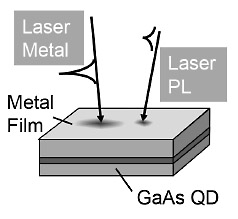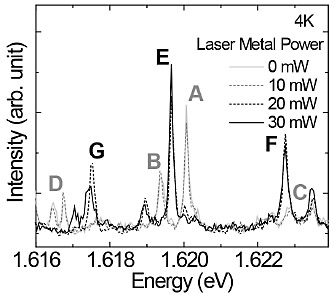Modification of Exciton Optical Properties with Coherent Phonons inQuantum Dots
Optically active semiconductor quantum dots (QDs) have been extensively studied because they are good candidates for quantum devices. Quantum devices rely on the optical properties of the excitons in QDs, which exist more stably than in other semiconductors. Excitons should be coherently manipulated without any decoherence processes for quantum device applications. Previously, optical, electric, and magnetic fields have been employed as sources for the manipulation. In this report, we show that coherent phonons induced by ultrafast optical pulses will provide a good new approach to QD manipulation [1].
The QD sample used in the measurement was based on GaAs/AlGaAs quantum wells (QWs) fabricated on an undoped (001) GaAs substrate. The QDs were formed in a thin (4.2 nm thick) GaAs layer sandwiched between AlGaAs barriers. The QD sample had a 100 nm-thick titanium film on its surface and the QDs were located 100 nm below the surface. In the measurement, we used a pulse laser (duration: 150 fs, repetition: 80 MHz, energy: 1.653 eV) as the excitation source. Optical pulses from the source were divided into two paths: one (Laser PL) was for creating excitons in QDs and the other (Laser Metal) was for illuminating the metal film as in Fig. 1. Figure 2 shows the PL spectra for different laser metal intensities with the laser PL power constant. Fine well-separated PL peaks were seen in the PL spectrum for laser PL (Laser Metal = 0 mW). The PL peaks originated from single excitons confined in the QDs. The spectra changed greatly with increases in Laser Metal intensity. These phenomena cannot be explained simply in terms of the heating effects induced by the laser metal. As an alternative way of evaluating the effects of illuminating metal, we also measured the reflectance properties using an optical interferometric method. Clear time-oscillating interferometric signals were observed that responded to the intensity of Laser Metal. The oscillating signals confirmed that coherent phonons were created in the QD sample. In QDs, coherent phonons form time- and space-oscillating strain waves leading to a change in the PL properties. The coherent phonons will constitute a new manipulation source whose response time is much shorter than that of previous methods employing ultrafast optical sources.
- [1]
- H. Gotoh, H. Sanada, H. Yamaguchi, and T. Sogawa, Appl. Phys. Lett. 103 (2013) 112104.
 |
 |
|
|